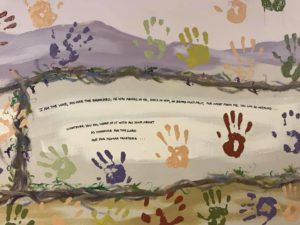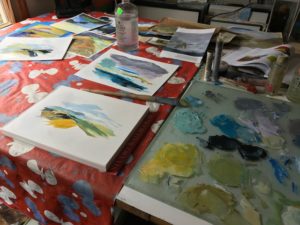 Yesterday in studio I worked up a palette of hues in oil, building from a photo I’d saved of an arctic scene in National Geo. You can see that here if you look closely at my messy table. I mixed up a set of replicated hues, pleasing together, and then added notes of my own with them, before I had any idea what I would do myself with this color grouping.
Yesterday in studio I worked up a palette of hues in oil, building from a photo I’d saved of an arctic scene in National Geo. You can see that here if you look closely at my messy table. I mixed up a set of replicated hues, pleasing together, and then added notes of my own with them, before I had any idea what I would do myself with this color grouping.
Then I took several prepared papers, and one rubber brush and started making marks. My angled rubber tool is pretty cool for I can switch easily from hue to hue by just quickly wiping it down. This gives me a brief freedom. I can vary the stroke widths by the angle, and modulate the intensity of the laid down paint so easily that exercises with this tool become play. For me, quick work like this gets better at what is deeply inside me than labored more planned out attempts at perfection.
The artic quiet of the original image had me captivated, the skies in that photo looked foreboding. And that’s maybe why I selected it. The skies outside my window were carrying ominous hints too as hurricane bands are moving our way. But things move slow. And it’s in the slowness where I live. Things that matter take so much time! I ponder this and my soul is impatient to the point of unease. That’s maybe also why quick work is so cathartic to me. And so I purposed to just make marks, to let my arms work it out, to try to outline it, as if prompting a resolve. This work is like prayer, it suddenly occurs to me. It happens only because things are not right. It’s productive, learned and practiced because there is felt need. I’m looking out, but “we’re not there yet.”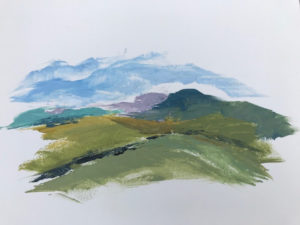
The Irish writer Josephine Hart said “there is an eternal landscape, a geography of the soul; we search for its outlines all our lives.” And Jesus praised those who hunger and thirst for the things that matter most. I think this is why I keep articulating the contours of horizon.
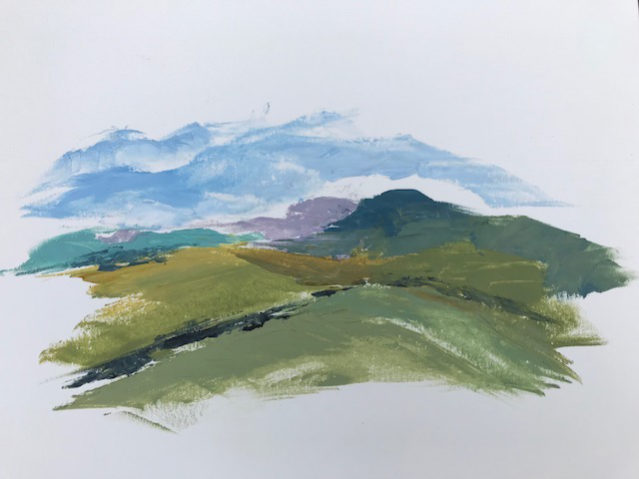

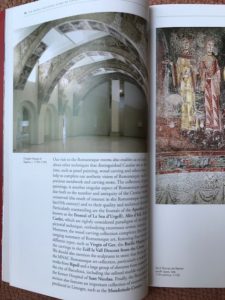 Barcelona’s National Museum of Catalonia has a collection of Romanesque murals that is unmatched by any museum in the world! Room after room gives one almost a time-machine opportunity to enter spaces that were situated in humble towns in the Pyrenees Mountains of Eastern Spain. These murals and sculptural pieces were then carefully removed to be preserved in the museum (imagine the public and private involvement to carry that feat out). Arranged in chronological (therefore stylistic) order, the spaces reveal the emerging imagery from small churches of the medieval period (11th-13thcenturies). What’s available then is a visualization of homegrown private conviction which was developed then displayed for public engagement. What was once internal became publically shared and what was then public becomes privately better understood. And this then down thru centuries for others to consider. Past into present. Imagine that ripple effect.
Barcelona’s National Museum of Catalonia has a collection of Romanesque murals that is unmatched by any museum in the world! Room after room gives one almost a time-machine opportunity to enter spaces that were situated in humble towns in the Pyrenees Mountains of Eastern Spain. These murals and sculptural pieces were then carefully removed to be preserved in the museum (imagine the public and private involvement to carry that feat out). Arranged in chronological (therefore stylistic) order, the spaces reveal the emerging imagery from small churches of the medieval period (11th-13thcenturies). What’s available then is a visualization of homegrown private conviction which was developed then displayed for public engagement. What was once internal became publically shared and what was then public becomes privately better understood. And this then down thru centuries for others to consider. Past into present. Imagine that ripple effect.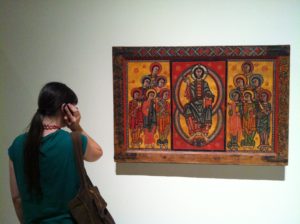 Here is a wooden altar panel I especially loved for its graphic punch, simplicity, and pattern. It’s a typical example of Byzantine flatness. Yet the abstraction of forms were rendered with human differentiation and quirkiness. The viewer of the time would have been able to relate. And the viewer now is carried into another world’s way of seeing, even if just catching a glimpse. What was private conviction of the artist became embedded in his public context, what simmered inwardly became visible for others to be able to look and see.
Here is a wooden altar panel I especially loved for its graphic punch, simplicity, and pattern. It’s a typical example of Byzantine flatness. Yet the abstraction of forms were rendered with human differentiation and quirkiness. The viewer of the time would have been able to relate. And the viewer now is carried into another world’s way of seeing, even if just catching a glimpse. What was private conviction of the artist became embedded in his public context, what simmered inwardly became visible for others to be able to look and see.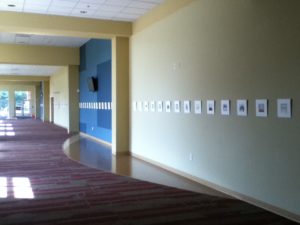
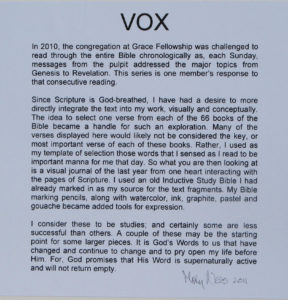
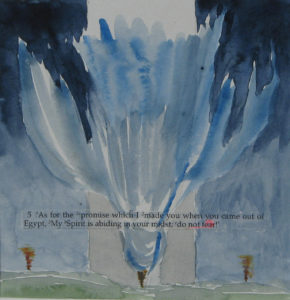
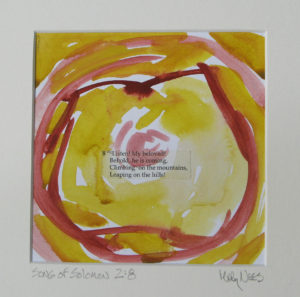 The little ones around us this week are learning to wait. “Can we have Daddy’s cake now that you have come in the door?” “Nini, can I play (bang) on the piano now?!’ “Are you done resting?” “Are you awake?” “Can you tell that story again Pop? Let’s go back in my room and pretend you’re putting me to bed! Tell it to me again, Pop!”
The little ones around us this week are learning to wait. “Can we have Daddy’s cake now that you have come in the door?” “Nini, can I play (bang) on the piano now?!’ “Are you done resting?” “Are you awake?” “Can you tell that story again Pop? Let’s go back in my room and pretend you’re putting me to bed! Tell it to me again, Pop!” Back to earth, there is something in Job’s proclamation that does ring true for me. I have ideas and ambition, but unless my hands get busy, unless I have the courage to learn from the messes, and unless I manifest it somewhere. I have nothin’. Yesterday I picked up from the post office a piece which has been all over the country in a 3 year traveling show:
Back to earth, there is something in Job’s proclamation that does ring true for me. I have ideas and ambition, but unless my hands get busy, unless I have the courage to learn from the messes, and unless I manifest it somewhere. I have nothin’. Yesterday I picked up from the post office a piece which has been all over the country in a 3 year traveling show: 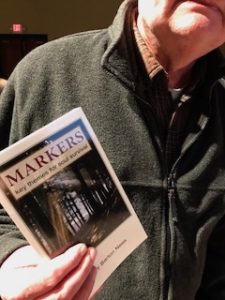
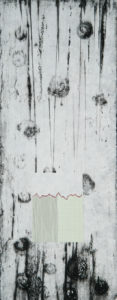 I showed them some pieces like this one, “Time and Mercy” where the chaos is falling down all around the inner life. But there on the inside is the mark of a heartbeat, and the recording of time. There’s a history that is undeniable, part of the fabric that cannot be changed. There’s a span ahead yet unknown. But in this present moment I can breathe and pause. This is the potential moment where beauty is born. For right now I can lift my head because the evidence of love is still shining through for those who are eager for it.
I showed them some pieces like this one, “Time and Mercy” where the chaos is falling down all around the inner life. But there on the inside is the mark of a heartbeat, and the recording of time. There’s a history that is undeniable, part of the fabric that cannot be changed. There’s a span ahead yet unknown. But in this present moment I can breathe and pause. This is the potential moment where beauty is born. For right now I can lift my head because the evidence of love is still shining through for those who are eager for it.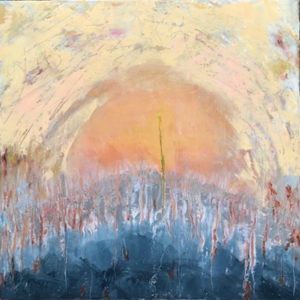 The theme keeps repeating and it’s a universal one. From mythology to classic literature this idea of trekking toward some kind of attainment is in our DNA. Moses, Odysseus, Buddha, Lao Tzu, Dante — the list is long of courageous ones who were answering the ancient quest “where have you come from, and where are you going?”* Something keeps us moving, sometimes for what we’re not even sure; and if our bodies get tired, our spirits keep longing.
The theme keeps repeating and it’s a universal one. From mythology to classic literature this idea of trekking toward some kind of attainment is in our DNA. Moses, Odysseus, Buddha, Lao Tzu, Dante — the list is long of courageous ones who were answering the ancient quest “where have you come from, and where are you going?”* Something keeps us moving, sometimes for what we’re not even sure; and if our bodies get tired, our spirits keep longing.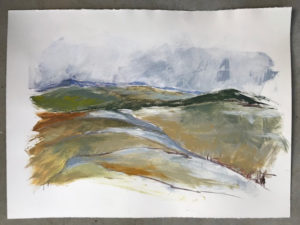 cam. It’s lived so slow from our angle. We move here on the ground at a snail’s response to what is happening second by second in the heavenlies. My sky here is active, for that’s where the real drama is being directed. The land only reflects the weather patterns and the light working above it. I live on the ground, held by gravity, where time creeps sometimes agonizingly slow. I don’t like that slowness, for there’s so much that needs to change down here, so much I long for from the only One who can bring us justice and peace. Humans and their leaders so disappoint me! He said He’d return, why is He taking so long!?
cam. It’s lived so slow from our angle. We move here on the ground at a snail’s response to what is happening second by second in the heavenlies. My sky here is active, for that’s where the real drama is being directed. The land only reflects the weather patterns and the light working above it. I live on the ground, held by gravity, where time creeps sometimes agonizingly slow. I don’t like that slowness, for there’s so much that needs to change down here, so much I long for from the only One who can bring us justice and peace. Humans and their leaders so disappoint me! He said He’d return, why is He taking so long!?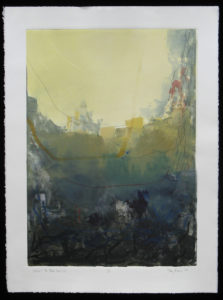 A good portion of my work is an intuitive response, rapidly laid down. This does not mean that the result seen on paper was altogether quick, though if you had watched this piece and others being birthed you might think so. What is visible is an end product of a long term simmering from my mind, spirit and body. The thoughts that collide toward and then into a particular working session, the prayers that have been raised and linger as I craft, and the arms and legs that labor this forward are mine.
A good portion of my work is an intuitive response, rapidly laid down. This does not mean that the result seen on paper was altogether quick, though if you had watched this piece and others being birthed you might think so. What is visible is an end product of a long term simmering from my mind, spirit and body. The thoughts that collide toward and then into a particular working session, the prayers that have been raised and linger as I craft, and the arms and legs that labor this forward are mine.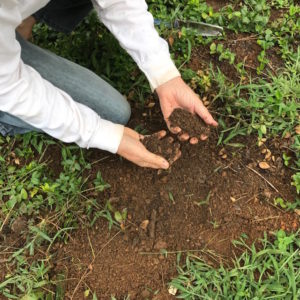 All this and more fascinates me for the Creation account in Genesis 2 has God Himself getting his hands into the dirt, in time, on the ground to make things. Then we are tasked, after His exampling, to make things. It’s in the making that seeing is enhanced. It’s in the time taken and slowed down where relationships are better understood. It’s work, but strangely hope-filled.
All this and more fascinates me for the Creation account in Genesis 2 has God Himself getting his hands into the dirt, in time, on the ground to make things. Then we are tasked, after His exampling, to make things. It’s in the making that seeing is enhanced. It’s in the time taken and slowed down where relationships are better understood. It’s work, but strangely hope-filled.